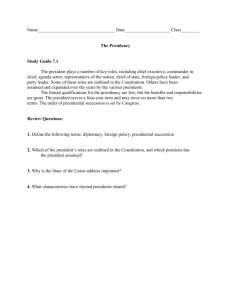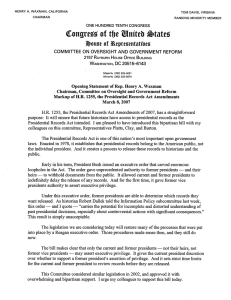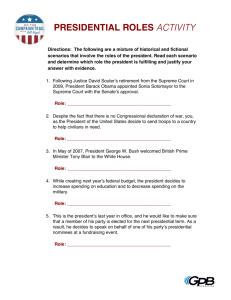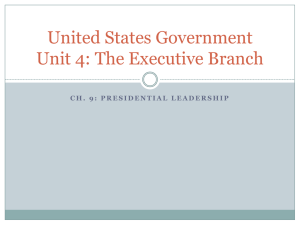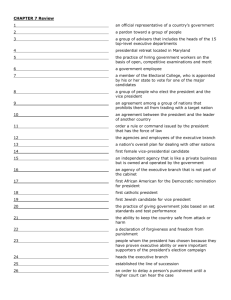Presidential-Congressional Relations in an Era of Jon R. Bond Richard Fleisher
advertisement
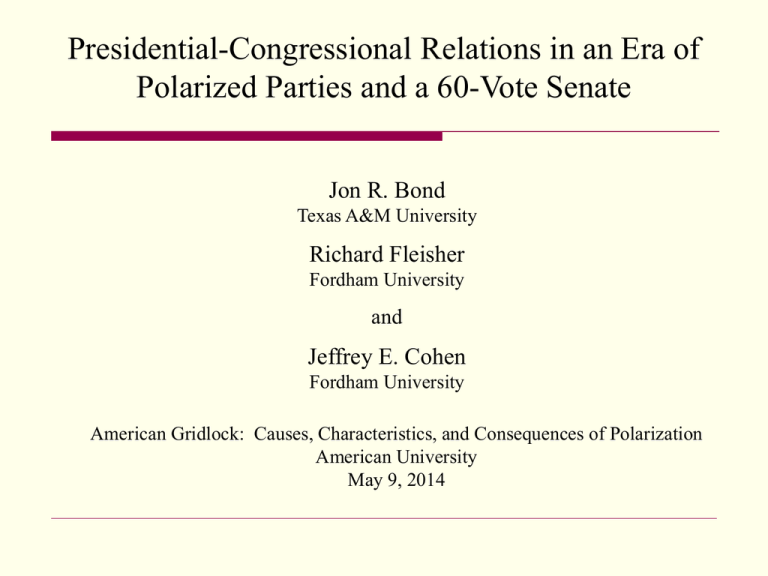
Presidential-Congressional Relations in an Era of Polarized Parties and a 60-Vote Senate Jon R. Bond Texas A&M University Richard Fleisher Fordham University and Jeffrey E. Cohen Fordham University American Gridlock: Causes, Characteristics, and Consequences of Polarization American University May 9, 2014 Basics of Presidential-Congressional Relations The president needs Congress to vote to support his positions It’s a hard sell Some presidents are more successful than others Party control of Congress is the most important determinant of success The president wins more roll calls if his party has a majority The advantage of majority control is less in the Senate Or more accurately: the disadvantage of minority status is less in the Senate Party Polarization in Congress has altered this relationship Different effects in the House & Senate Majority presidents still win more often in both chambers, but polarization Amplifies the benefit of majority control in the House: Majority presidents win more; minority presidents win ( a lot) less Suppresses success rates of both majority & minority presidents in the Senate The Puzzle Why does polarization suppress presidential success in the Senate? The short answer: (paraphrasing a motivational line from Clinton’s campaign book) “It’s the minority Party filibuster stupid” Evidence of the Minority Party Filibuster Exponential increase in cloture votes over time (Fig. 1) Before Clinton cloture less common on presidential roll calls (Fig. 2) Institutionalization of 60-vote Senate by George W. Bush administration Transformed filibuster & cloture into Minority Party tool (Fig. 3) Figure 1 Cloture Votes on Senate Roll Calls (by presidential administration) 40% Percentage 30% 20% y = 0.00005x2 - 0.00009x + 0.00275 R² = 0.96653 BHO GWB Other super-maj pres roll calls 10% WJC GHWB y = 0.00x + 0.02 R² = 0.17 RWR RMN/GRF JFK/LBJ JEC Cloture on all roll calls DDE 0% 1953 1957 1961 1965 1969 1973 1977 1981 1985 Year 1989 1993 1997 2001 2005 2009 2013 Figure 1 Cloture Votes on Senate Roll Calls (by presidential administration) 40% Percentage 30% 20% y = 0.00005x2 - 0.00009x + 0.00275 R² = 0.96653 BHO GWB Other super-maj pres roll calls 10% WJC GHWB y = 0.001x + 0.023 R² = 0.171 RWR RMN/GRF JFK/LBJ JEC Cloture on all roll calls DDE 0% 1953 1957 1961 1965 1969 1973 1977 1981 1985 Year 1989 1993 1997 2001 2005 2009 2013 Figure 1 Cloture Votes on Senate Roll Calls (by presidential administration) 40% Percentage 30% 20% y = 0.00005x2 - 0.00009x + 0.00275 R² = 0.96653 BHO GWB Other super-maj pres roll calls 10% WJC GHWB y = 0.0008x + 0.0231 R² = 0.1711 RWR RMN/GRF JFK/LBJ JEC Cloture on all roll calls DDE 0% 1953 1957 1961 1965 1969 1973 1977 1981 1985 Year 1989 1993 1997 2001 2005 2009 2013 Evidence of Minority Party Filibuster Exponential increase in cloture votes over time (Fig. 1) Before Clinton, cloture less common on presidential roll calls (Fig. 2) Institutionalization of 60-vote Senate by George W. Bush administration Transformed filibuster & cloture into Minority Party tool (Fig. 3) Figure 1 Cloture Votes on Senate Roll Calls (by presidential administration) 40% Percentage 30% 20% y = 0.00005x2 - 0.00009x + 0.00275 R² = 0.96653 BHO GWB Other super-maj pres roll calls 10% WJC GHWB y = 0.00x + 0.02 R² = 0.17 RWR RMN/GRF JFK/LBJ JEC Cloture on all roll calls DDE 0% 1953 1957 1961 1965 1969 1973 1977 1981 1985 Year 1989 1993 1997 2001 2005 2009 2013 Figure 2 Cloture and Cloture-Related Votes on Presidential Roll Calls 40% BHO w/ UCA60 , 34% GWB w/ UCA60 , 30% 30% Percentage GWB, 23% 20% BHO , 15% Other super-maj pres roll calls WJC, 10% 10% GHWB, 6% RWR, 3% JFK/LBJ, 1% RMN/GRF, 1% DDE, 0.0% JEC, 1% Cloture on all roll calls 0% 1953 1957 1961 1965 1969 1973 1977 1981 1985 Year 1989 1993 1997 2001 2005 2009 2013 Evidence of Minority Party Filibuster Exponential increase in cloture votes over time (Fig. 1) Before Clinton, cloture less common on presidential roll calls (Fig. 2) Institutionalization of 60-vote Senate by George W. Bush administration Transformed filibuster & cloture into Minority Party tool (Fig. 3) Figure 2 Cloture and Cloture-Related Votes on Presidential Roll Calls 40% BHO w/ UCA60 , 34% GWB w/ UCA60 , 30% 30% Percentage GWB, 23% 20% BHO , 15% Other super-maj pres roll calls WJC, 10% 10% GHWB, 6% RWR, 3% JFK/LBJ, 1% RMN/GRF, 1% DDE, 0.0% JEC, 1% Cloture on all roll calls 0% 1953 1957 1961 1965 1969 1973 1977 1981 1985 Year 1989 1993 1997 2001 2005 2009 2013 Figure 2 Cloture and Cloture-Related Votes on Presidential Roll Calls 40% BHO w/ UCA60 , 34% GWB w/ UCA60 , 30% 30% Percentage GWB, 23% 20% BHO , 15% Other super-maj pres roll calls WJC, 10% 10% GHWB, 6% RWR, 3% JFK/LBJ, 1% RMN/GRF, 1% DDE, 0.0% JEC, 1% Cloture on all roll calls 0% 1953 1957 1961 1965 1969 1973 1977 1981 1985 Year 1989 1993 1997 2001 2005 2009 2013 Evidence of Minority Party Filibuster Exponential increase in cloture votes over time (Fig. 1) Before Clinton, cloture less common on presidential roll calls (Fig. 2) Institutionalization of 60-vote Senate by George W. Bush administration Transformed filibuster & cloture into Minority Party tool No formal change in cloture rule (or its interpretation until Nov. 2013 nuclear option) But behavior changed—voting on presidential roll calls has become highly partisan Partisanship increased on all types of presidential roll calls Especially high on cloture votes (Fig. 3) Figure 3 High Party Unity on Cloture and Other Presidential Roll Calls 100% Cloture Other supermajority votes 90% Majority votes 83% Percent of Votes with Party Difference GT .80 80% 67% 60% 47% 40% 31% 20% 0% DDE JFK/LBJ RMN/GRF JEC RWR GHWB WJC GWB BHO How Does Polarization Affect Presidential Success? House: Augments advantage of majority control As polarization increases, majority presidents win more; minority presidents win less (Fig. 4a) Figure 4a The Effects of Party Polarization on House Presidential Success 100% Majority Presidents y = 0.55x + 0.42 R² = 0.44 80% 55% Presidential Success 22% 60% 40% 20% Minority Presidents y = -1.10x + 1.18 R² = 0.63 0% 30% 40% 50% 60% 70% Party Votes 80% 90% 100% Figure 4a The Effects of Party Polarization on House Presidential Success 100% Majority Presidents y = 0.55x + 0.42 R² = 0.44 80% 55% Presidential Success 22% 60% 40% 20% Minority Presidents y = -1.10x + 1.18 R² = 0.63 0% 30% 40% 50% 60% 70% Party Votes 80% 90% 100% Figure 4a The Effects of Party Polarization on House Presidential Success 100% Majority Presidents y = 0.55x + 0.42 R² = 0.44 80% 55% Presidential Success 22% 60% 40% 20% Minority Presidents y = -1.10x + 1.18 R² = 0.63 0% 30% 40% 50% 60% 70% Party Votes 80% 90% 100% Figure 4a The Effects of Party Polarization on House Presidential Success 100% Majority Presidents y = 0.55x + 0.42 R² = 0.44 80% 55% Presidential Success 22% 60% 40% 20% Minority Presidents y = -1.10x + 1.18 R² = 0.63 0% 30% 40% 50% 60% 70% Party Votes 80% 90% 100% How Does Polarization Affect Presidential Success? Senate: Suppresses presidential success As polarization increases, success rates of both majority & minority presidents decrease (Fig. 4b) If it’s the filibuster & cloture, then the pattern on non-cloture votes should look more like the House (Fig. 4c) And the pattern of presidential success on cloture votes, should be a mirror image of the House (Fig. 4d) Figure 4b The Effects of Party Polarization on Senate Presidential Success 100% 80% Presidential Success 20% Majority Presidents y = -0.21x + 0.90 R² = 0.06 23% 60% Minority Presidents y = -0.33x + 0.77 R² = 0.10 40% 20% 0% 30% 40% 50% 60% 70% Party Votes 80% 90% 100% Figure 4b The Effects of Party Polarization on Senate Presidential Success 100% 80% Presidential Success 20% Majority Presidents y = -0.21x + 0.90 R² = 0.06 23% 60% Minority Presidents y = -0.33x + 0.77 R² = 0.10 40% 20% 0% 30% 40% 50% 60% 70% Party Votes 80% 90% 100% Figure 4b The Effects of Party Polarization on Senate Presidential Success 100% 80% Presidential Success 20% Majority Presidents y = -0.21x + 0.90 R² = 0.06 23% 60% Minority Presidents y = -0.33x + 0.77 R² = 0.10 40% 20% 0% 30% 40% 50% 60% 70% Party Votes 80% 90% 100% Figure 4b The Effects of Party Polarization on Senate Presidential Success 100% 80% Presidential Success 20% Majority Presidents y = -0.21x + 0.90 R² = 0.06 23% 60% Minority Presidents y = -0.33x + 0.77 R² = 0.10 40% 20% 0% 30% 40% 50% 60% 70% Party Votes 80% 90% 100% How Does Polarization Affect Presidential Success? Senate: Suppresses Success Rates As polarization increases, Success rates of both majority & minority presidents decrease (Fig. 4b) If the minority party filibuster is the cause, then the pattern on non-cloture votes should look more like the House (Fig. 4c) And the pattern of presidential success on cloture votes, should be a mirror image of the House (Fig. 4d) Figure 4a The Effects of Party Polarization on House Presidential Success 100% Majority Presidents y = 0.55x + 0.42 R² = 0.44 80% 55% Presidential Success 22% 60% 40% 20% Minority Presidents y = -1.10x + 1.18 R² = 0.63 0% 30% 40% 50% 60% 70% Party Votes 80% 90% 100% Figure 4b The Effects of Party Polarization on Senate Presidential Success 100% 80% Presidential Success 20% Majority Presidents y = -0.21x + 0.90 R² = 0.06 23% 60% Minority Presidents y = -0.33x + 0.77 R² = 0.10 40% 20% 0% 30% 40% 50% 60% 70% Party Votes 80% 90% 100% Figure 4c The Effects of Party Polarization on Senate Presidential Success (Non-cloture) 100% Majority Presidents y = 0.15x + 0.71 R² = 0.06 80% 36% Presidential Success 24% 60% Minority Presidents y = -0.46x + 0.84 R² = 0.18 40% 20% 0% 30% 40% 50% 60% 70% Party Votes 80% 90% 100% How Does Polarization Affect Presidential Success? Senate: Suppresses Success Rates As polarization increases, Success rates of both majority & minority presidents decrease (Fig. 4b) If it’s the filibuster & cloture, then the pattern on non-cloture votes should look more like the House (Fig. 4c) And the pattern of presidential success on cloture votes, should be a mirror image of the House (Fig. 4d) Why is a 60-vote Senate so hard on majority presidents? It’s just simple arithmetic of the minority party filibuster (Table 1) Figure 4a The Effects of Party Polarization on House Presidential Success 100% Majority Presidents y = 0.55x + 0.42 R² = 0.44 80% 55% Presidential Success 22% 60% 40% 20% Minority Presidents y = -1.10x + 1.18 R² = 0.63 0% 30% 40% 50% 60% 70% Party Votes 80% 90% 100% Figure 4d The Effects of Party Polarization on Senate Presidential Success (Cloture) 100% Minority Presidents y = 2.06x - 0.78 R² = 0.50 Presidential Success 80% 60% 40% 16% 72% 20% Majority Presidents y = -0.74x + 0.74 R² = 0.19 0% 30% 40% 50% 60% 70% Party Votes 80% 90% 100% How Does Polarization Affect Presidential Success? Senate: Suppresses Success Rates As polarization increases, Success rates of both majority & minority presidents decrease (Fig. 4b) If it’s the filibuster & cloture, then the pattern on non-cloture votes should look more like the House (Fig. 4c) And the pattern of presidential success on cloture votes, should be a mirror image of the House (Fig. 4d) Why is a 60-vote Senate so hard on majority presidents? It’s just simple arithmetic of the minority party filibuster (Table 1) Table 1 Presidential Positions on Cloture Votes Pre-Bush Years Bush/Obama Years All Years Majority Presidents Yea 95.7% (40/59) (44/46) 83.3% 97.6% (30/36) (81/83) 73.7% 96.9% (70/95) (125/129) Presidents win 93% if they opposed invoking cloture vs. 15% if they support it Minority Presidents Nay 67.8% It’s a lot easier to win if you only need 41 votes rather than 60 Minority party presidents usually oppose invoking cloture (74% nay positions) Increased from 68% in pre-Bush years to 83% for Bush & Obama Majority party presidents almost always support cloture (97% yea positions) Not much room to increase in recent years (96% to 98%) But Bush & Obama took positions on 83 cloture votes vs. 46 in pre-Bush years Conclusions Party polarization: different effects on presidential success in the House & Senate House: As parties become more cohesive, party control becomes more important—majority party presidents win more; minority party presidents win less Why? House is a majoritarian institution Cohesive majorities help majority presidents & hinder minority presidents Senate: As parties become more cohesive, both majority & minority presidents win less Why? Senate is a super-majoritarian institution Cohesive parties hinder both majority & minority presidents Majority presidents less likely to get opposition votes necessary to invoke cloture Minority presidents less able to impede scheduling of objectionable floor votes Thank you Jon, Rich, and Jeff Figure 1 Partisanship on Presidential Roll Calls in the House and Senate 40% Senate more partisan 30% 20% 10% WJC, 3% RMN/GRF, 0% GWB, 0% 0% JEC, -4% BHO, -5.8% DDE, -7% Senate less partisan RWR, -9% -10% GHWB, -8% JFK/LBJ, -14% -20% -30% -40% 1953 1957 1961 1965 1969 1973 1977 1981 1985 Year 1989 1993 1997 2001 2005 2009 2013 Figure 3a Partisanship on Cloture and Other Presidential Votes 100% Cloture Other supermajority votes Mmajority votes 91% 87% 82% 80% Mean Difference in Party Positions 73% 66% 59% 60% 40% 34% 23% 20% 0% DDE JFK/LBJ RMN/GRF JEC RWR GHWB WJC GWB BHO The Measures Dependent Variable: Presidential Success Score Annual percentage of presidential victories on conflictual roll calls,1953-2013 Party Control 1 if president’s party controls the chamber; 0 otherwise Why not use interval measure w/ more information (percent of president’s party)? More on this shortly Party Polarization Annual percentage of conflictual roll calls w/ majority of Dems. vs. majority of Reps. Exclude consensus roll calls (less than 10% in the minority) Interpretation: percentage of all conflict on roll call votes that is party conflict Presidential popularity Average annual percentage approving of the president’s job performance (Gallup) Wouldn’t it be better to use percent of the president’s party? Dichotomous party control variable throws out information Standard practice is to use percent of the president’s party Does the interval measure add useful information over the simple majority/minority dichotomy? Not much Primary benefit of party control = president’s co-partisans control key levers of power (committees; agenda control) Let’s look at some evidence (Table 1) Table 1 The Effects of Party Control & the President’s Party Margin on Presidential Success in the House & Senate, 1953-2010 Variables House Senate 38.49 11.97 (5.57) (2.10) -0.13 0.37 (-0.71) (2.18) 41.24 55.87 (11.36) (18.77) N 58 58 R2 0.61 0.47 Party Control (majority party president = 1) President’s Party Margin (President’s party % - Opposition party %) Constant t-values in parentheses Significant coefficient for president’s party margin in the Senate Implies that percent of president’s party has independent effects in the Senate Magnitude of effect seems similar to party control dummy Plot of the relationships suggests a different interpretation Figure 1 The Relationship between Party Control & Presidential Success in the House 100 90 Overall y =0.73x + 58.68 R =0.39 80 Presidential Success Score 70 60 50 40 30 20 10 0 -50 -40 -30 -20 -10 0 President's Party Margin 10 20 30 40 50 Figure 1 The Relationship between Party Control & Presidential Success in the House 100 90 Overall y =0.73x + 58.68 R =0.39 80 Presidential Success Score 70 60 50 M inority Presidents y = -0.19x + 40.27 R = 0.01 40 30 20 10 0 -50 -40 -30 -20 -10 0 President's Party Margin 10 20 30 40 50 Figure 1 The Relationship between Party Control & Presidential Success in the House 100 90 Overall y =0.73x + 58.68 R =0.39 80 M ajority Presidents y = -0.07x + 78.71 R = 0.01 Presidential Success Score 70 60 50 M inority Presidents y = -0.19x + 40.27 R = 0.01 40 30 20 10 0 -50 -40 -30 -20 -10 0 President's Party Margin 10 20 30 40 50 Figure 2 The Relationship between Party Control & Presidential Success in the Senate 100 90 Overall y =0.66x + 61.02 R =0.42 80 Presidential Success Score 70 60 50 40 30 20 10 0 -50 -40 -30 -20 -10 0 President's Party Margin 10 20 30 40 50 Figure 2 The Relationship between Party Control & Presidential Success in the Senate 100 90 Overall y =0.66x + 61.02 R =0.42 80 Presidential Success Score 70 60 50 40 M inority Presidents y = 0 .5 5 x + 57.85 R 2 = 0 .13 30 20 10 0 -50 -40 -30 -20 -10 0 President's Party Margin 10 20 30 40 50 Figure 2 The Relationship between Party Control & Presidential Success in the Senate 100 90 Overall y =0.66x + 61.02 R =0.42 80 M ajority Presidents y = 0.27x + 69.49 R = 0.05 Presidential Success Score 70 60 50 40 M inority Presidents y = 0 .5 5 x + 57.85 R 2 = 0 .13 30 20 10 0 -50 -40 -30 -20 -10 0 President's Party Margin 10 20 30 40 50

